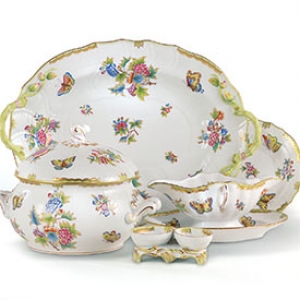
 Online Shop You don't have products
Online Shop You don't have products in your cart

In less than a decade Herend Manufacture will celebrate its second Centenary. It began in the Hungarian town from which it took its name. It was born a hundred years after the porcelain manufacture was initiated at the beginning of the 18th Century in Europe: first in Germany, later on in France and subsequently in England. This lapse of time has not been an obstacle however, but quite the opposite. The Herend porcelain has reached such a high level of excellence that it is placed amongst the oldest European manufacturers.
Birth of a magnificent porcelain factory
More than 180 have passed since Vince Stingh created his small porcelain workshop in 1826, not far from the Balaton Lake asnd not too long before the name of this small town called Herend became known worldwide. In 1939 the factory came under the direction of Mor Fischer and between 1851 and 1937 Herend won gold medals and other prizes for its products of fine quality in several international Fairs like, London, Paris, Brussels, Venice and New York, to name but a few. This was a significant sign that Herend had now achieved a place among the great porcelain manufacturers. Since then it has maintained successfully the prestigious reputation gained in a world of constant evolution.
Herend porcelain in Europe
One of the titles that most distinguished the Herend Factory was when it became the official supplier to the Hapsburg Family Court. The excellent quality of the hand-painted products and the rich variety of patterns became the favorite among the aristocracy of Hungary and abroad.
A number of aristocratic families still appear among the Herend patterns: Appony, Esterhazy, Rothschild and Liechtenstein. In fact Godollo got its name from the Emperor Francis Joseph and his Empress Elizabeth. It was made for their Hungarian Palace of Godollo. The Welsh design was later used in the Coronation of Edward VII.
However, the real coming out took place a quarter of a Century after its foundation. The first World Fair was to be celebrated in 1851in London. Queen Victoria ordered an extensive dinner service for Windsor Castle, the pattern we know today as “Victoria”. It drew so much attention from the European Royal Families, which gave it an outstanding international reputation that to this day lives on.
Since then Herend manufacture is synonymous to porcelain quality. It is one of the biggest in the world with 700 employees present in more than sixty countries. It is known for elegant patterns that combine tradition and the spirit inherited from its ancestors. This includes constant technological innovation and a permanent desire to adapt to the evolution of aesthetic tastes of the XXI Century.
For those of us who are familiar with the wide decorative range of Herend, continue to admire the patterns that are well known internationally. I mentioned before the famous Victoria pattern that so attracted the British Sovereign in 1851. This combines almost a hundred butterfly clusters. Also the flowers painted in bright colors that since then have been reproduced today in an immense variation of colors.
Shortly after the Victoria Herend created another pattern that would be as famous as the Victoria, called Rothschild, after the well known family of bankers who ordered dinner services decorated with different birds. The story goes that the Baroness Rothschild lost her necklace in the garden of her palace. Some days later the gardener saw a couple of birds playing with something bright and discovered that it was the necklace belonging to the Baroness. Ever since then each plate of this prestigious dinner service is a necklace held by two birds.
The pattern has been redesigned and interpreted fully over the last decades. A third decorative pattern we can identify with Herend is the “fleur des Indies”, manufactured in 1930 for the Hungarian politician Count Albert Appony representing a peony as the main motif. It is a simple motif, but so elegant, and in a short time due to its success became one of the most popular patterns of Herend . Today this pattern is manufactured in 10 different colors.
Herend porcelain today.
Tradition and innovation are characteristic of Herend and along with the most famous patterns designers today develop new patterns and mix colors, combining white, gold, blue and black.
After opening the first hand craft workshops, most of which disappeared in the Industrial Revolution, the Herend Factory continues to produce to perfection the Herend porcelain, which is of course synonymous to a rich variety of designs, an elegant style and a wide range of pieces.. It is the factory with the largest production of handmade goods in Europe. Today it employs more than 1600 craftsmen, among them are 700 painters and 220 designers.
Herend is more than a product, it has become a legend.

